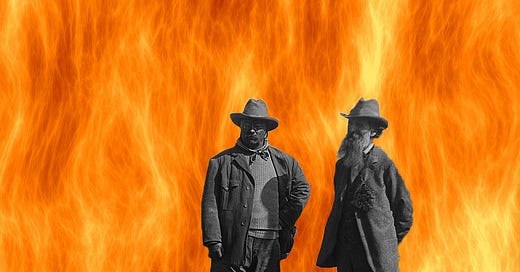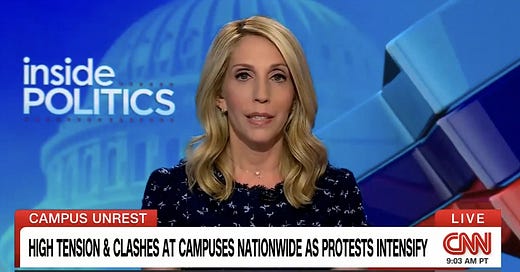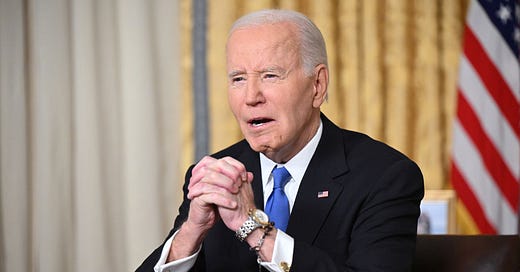
No Heroes: The Racist Legacy of John Muir and American Conservation
The sweeping beauty of America's National Parks hides an ugly history.
Welcome to No Heroes, a series about high pedestals, hard falls, and why you should (almost) never stan.
In 1903, famed naturalist John Muir and President Theodore Roosevelt embarked on a camping trip in California’s Yosemite Valley. During the now much-mythologized trip, the men talked over campfires, sat out under the stars, woke up to a surprise snowstorm, joked at each other’s expense, tried to out-talk each other, and even evaded the president’s entourage like kids playing hooky.
As the story goes, it was on this trip that Muir convinced Roosevelt to help preserve the region containing the Yosemite Valley and Mariposa Grove by returning it to federal protection as part of Yosemite National Park. Within a few years, the deed was done, marking a pivotal moment in the history of American conservation. During the course of his presidency, Roosevelt went on to establish five national parks, eighteen national monuments, and a hundred and fifty national forests.
Muir, meanwhile, is considered the “father” of the National Parks System to this day, and is himself a mythic figure. As the story goes, he was a gentle and hirsute Scotsman who, at 22 years old, suffered an accident at a factory in Indianapolis that left him temporarily blind. When he regained his eyesight, Muir left his life of industry and pledged himself to the natural world. He walked all the way to Florida before eventually making his way to California, studying plants along the way. Muir spent the rest of his life advocating for the environment. He co-founded The Sierra Club, wrote essays, lobbied for conservation, and became a national and historical icon.
Among his talents, Muir had a knack for writing reflections on nature that read like scripture:
“Thousands of tired, nerve-shaken, over-civilized people are beginning to find out that going to the mountains is going home; that wildness is a necessity; and that mountain parks and reservations are useful not only as fountains of timber and irrigating rivers, but as fountains of life.”
Beautiful. Muir also wrote this:
“Occasionally, a good countenance may be seen among the Mono Indians, but these, the first specimens I had seen, were mostly ugly, and some of them altogether hideous. The dirt on their faces was fairly stratified, and seemed so ancient and so undisturbed it might almost possess a geological significance...Somehow they seemed to have no right place in the landscape, and I was glad to see them fading out of sight down the pass.”
"...most Indians I have known are not a whit more natural in their lives than we civilized whites."
"The worst thing about them is their uncleanliness. Nothing wild is unclean."
“The negroes are easy-going and merry, making a great deal of noise and doing little work. One energetic white man, working with a will, would easily pick as much cotton as half a dozen Sambos and Sallies.”
“As to Indians, most of them are dead or civilized into useless innocence.”
John Muir held the natural world sacred and made it his life’s work to protect it, but his reverence for his fellow humans (as illustrated in much of his writing) is often indifferent at best, and the conservation efforts he championed frequently came at the expense of people who occupied the land long before evangelizing white settlers arrived. It makes sense that Muir is lauded in American history, because his story is perfectly American: enacting colonization and calling it enlightenment.
As far as the record shows, Muir doesn’t have literal blood on his hands, and plenty of ink has been spilled over forgiving him for views that were perhaps more about the time than the man, or documenting how his views evolved and changed over time. Those might be fair assessments, and indeed he does have more favorable writings about the indigenous people he encountered. Still, ignorance and erasure is its own kind of evil, especially considering the fact that Muir’s aims benefitted from the occupation and brute force of white settlers.
Take the Yosemite area, this supposedly pristine and untouched paradise that sent Muir into such raptures. While platitudes surrounding conservation are often nods to “wild” and “untouched” land, Yosemite was neither. The Native population of the Yosemite Valley—specifically, the Ahwahneechee Tribe, a subset of a larger group of Miwok tribes—had spent years not only maintaining the land, but actually helped create it and steward it with strategic fires that led to greater health and biodiversity.
Then, in 1851, a 49er aptly named James Savage pulled up to the area. He established a trading post, used and deceived the Ahwahneechee people, and incited violence that eventually led to military occupation and drove them out.
And when the Ahwahneechee people were gone, so was their work; in the subsequent years, the forests became overcrowded and vulnerable. Over 100 years after they were forced out, Yosemite’s Native people are still fighting for government recognition while it simultaneously uses them as an attraction.
Shortly after his camping trip with Muir, Roosevelt spoke to a crowd in Sacramento. During his address he said:
Lying out at night under those giant Sequoias was lying in a temple built by no hand of man, a temple grander than any human architect could by any possibility build, and I hope for the preservation of the groves of giant trees simply because it would be a shame to our civilization to let them disappear. They are monuments in themselves, I ask for the preservation of the other forests on grounds of wise and far-sighted economic policy. I do not ask that lumbering be stopped at all. On the contrary, I ask that the forests be kept for use in lumbering, only that they be so used that not only shall we here, this generation, get the benefit for the next few years, but that our children and our children’s children shall get the benefit… We are not building this country of ours for a day. It is to last through the ages.
“Our children and our children’s children shall get the benefit.” That sounds nice (the references to lumbering and economic policy, less so), but who are the children Roosevelt is referencing? In his mind, who was he protecting nature for and who was he protecting it from?
Roosevelt also said these words in 1886, which should give you some idea of where his priorities were:
I don’t go so far as to think that the only good Indian is the dead Indian, but I believe nine out of every ten are, and I shouldn’t like to inquire too closely into the case of the tenth.
Roosevelt was also perhaps the most famous imperialist in American history. The common thread linking all of these things together is the unabashed expansion of (white) American empire, whether at home or abroad—and no matter who or what gets trampled along the way.
This is all part of why the word “preservation” itself becomes itchy when you start to look under the surface. (Remember Blake Lively’s failed lifestyle brand Preserve, which featured, among other things, a post called “The Allure of Antebellum”?? No, probably not.) Descriptors like “pristine” and “pure” are a lot darker when accompanied by proper context, and it’s no wonder that long after they were established, National Park attendance is still overwhelmingly white. I wonder if Teddy would be proud of the crushing economic wall preventing many Americans from stepping inside nature’s cathedrals in 2020.
Looking back at Roosevelt’s calls for building a lasting legacy and his praise for nature’s monuments, it’s hard not to think about the many, newly impermanent man-made monuments being torn down around the world. A deeply racist statue of Roosevelt himself will soon be removed from the hallowed exterior of the American Museum of Natural History in New York (though the Theodore Roosevelt Memorial Hall and Theodore Roosevelt Rotunda will still remain standing just inside).
The larger historical reckoning happening at an accelerated pace right now is filled with varying degrees of delight and anguish. I chose John Muir to kick off No Heroes precisely because his legacy is one I’ve processed with some amount of pain and shame. I am unfortunately a Ken Burns bitch who actually bought the 12-hour, six-part The National Parks: America's Best Idea on goddamn DVD. I have a Badlands National Park t-shirt (I’ve never been to Badlands) and a Joshua Tree hat (I have been to Joshua Tree), I have an “America the Beautiful” parks pass, and my travel list is filled with destinations from New Mexico’s White Sands to Alaska’s Denali. I’ve revered, fawned, and felt the sacred power of the towering sequoias at Muir Woods National Monument. But preservation, even with its undeniable benefits, is still a dominating and frequently prejudiced act. It’s exclusionary by design, and the history of many of these parks goes hand in hand with the displacement of Native people. Pretending that nature preservation exists in a vacuum means looking away at the violence done to achieve it, and the people who suffered from it.
It isn’t just parks. The environmental movement as a whole has a racist history filled with everything from erasure and a lack of diversity in academia, to eugenics and white supremacy, and of course larger systemic issues, like the Sierra Club’s own anti-immigrant history. It’s a long and persistent legacy, and one that has flown under the radar for centuries.
I had planned on visiting Yosemite for the first very time this summer after relocating to California just before the COVID-19 pandemic hit. I wanted to camp out under the stars, shoot the shit with friends, and bask in the majesty of its vistas. Instead I’ll stay at home and bask in the many stories about bears, coyotes, bobcats, and deer who are reclaiming the park from invasive tourists. I look forward to someday seeing what inspired Muir so intensely, but for now, I’m OK staying away. The place was never mine to have anyway.
Image: PublicDomainPictures.net // Wikipedia
This post is part of Discourse University, an occasional series where we tackle history, ideas, and any other wonky kind of thing that strikes our fancy.














Good and necessary article. Like you, I'm a "fan" of the National Parks, of conservation, wildlife, and "wilderness", who has come to grapple with the contradictions inherent in the concept. I DID know much of what you relate here, from further reading on these figures. Both Muir and Roosevelt are complex figures, and I don't think either of them should be excused at all as "products of their time" (there were plenty of people, in their time and before, who did not hold their racist views; and even if both of them evolved in some ways over time, their legacies are checkered). I can still see the value in even the Ken Burns series... but it's better if you temper it with attention paid to what it doesn't say or cover. (I wonder how different it would be if he made it today?)
I'm not really sure what "the answer" is. But I also feel that if we don't have the perfect, all-encompassing answer to this history (and the wrongs done) or to this present, it shouldn't keep us from trying to address "smaller"-scale problems on the way towards trying to solve the bigger ones. Such as, trying indeed to make the Parks belong to, and accessible to, more Americans than just affluent white people. (I put "smaller" in quotation marks there, because that itself isn't a small problem at all.)
As a frequent user of public lands I found this piece very interesting and thought-provoking.
As a minor aside my hot take is that national parks, while beautiful, are generally lame due to tons of people, fees, and restrictions on fun stuff like hiking and camping: preservation is the focus. National forests and bureau of land management land however are way overlooked and where most of the fun is in my experience